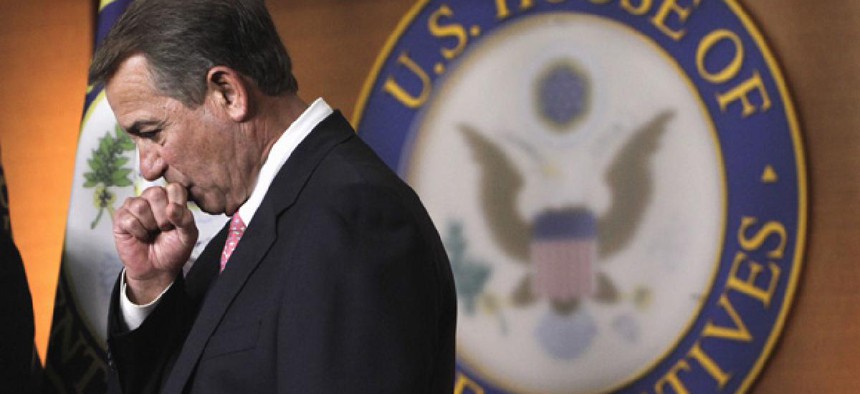
Rep. John Boehner, R-Ohio Jacquelyn Martin/AP file photo
The not-so-happy anniversary of the debt-ceiling crisis
The 2012 election will decide the real political meaning of the showdown.
One year ago, the United States was engulfed in the debt-ceiling crisis of 2011, a self-inflicted wound as egregious as it was avoidable. As events proceeded in July of last year, people around the world surely must have wondered whether politicians in the United States had gone mad. They were threatening to default on the nation's debt and destroy the world economy. Although the crisis was eventually resolved, it produced a downgrade of the country's credit rating, and some economists believe that the resulting hit to consumer confidence significantly damaged the economic recovery from the Great Recession. A year later, it is worth asking what it all meant. The debt-ceiling crisis was a failed attempt to stage a revolution in American politics with control of only one house of Congress; but the larger meaning of the crisis will depend on the 2012 presidential election.
The crisis began when congressional Republicans announced that they would refuse to authorize what had previously been a routine increase in the debt ceiling. By itself, raising the debt ceiling does not increase federal spending. It merely authorizes the Treasury Department to float new government bonds to pay the money that Congress has already appropriated.
Some congressional Republicans, particularly those allied with the Tea Party, argued that the nation had simply spent too much in the past and that the debt ceiling should not be raised at all. When confronted with the likely economic consequences of this strategy, they either downplayed or denied them. Other Republicans well understood the consequences, but they decided to use the debt ceiling as a fiscal hostage: They refused to vote for an increase unless President Obama agreed to significant cuts in government programs. The Republicans' ostensible goal was debt reduction, but they refused to allow any tax increases to achieve it. All debt reduction would have to come solely from spending cuts.
In the past, some politicians (including then-Senator Barack Obama) have voted against debt-ceiling increases for reasons of symbolism or protest, but not in situations where there was any actual danger that the increase would not occur. Now Republicans changed the rules of the game: They used the threat of economic catastrophe to force the president to adopt their preferred policies. As Senate Minority Leader Mitch McConnell put it in an excess of candor, threatening to default on the nation's debts was "a hostage that's worth ransoming [because] it focuses the Congress on something that must be done."
Obama was caught off guard. He had neglected to include a debt-ceiling increase in the April 2011 budget agreement because he did not believe that the Republicans would dare attempt such a maneuver. Seemingly confounded by the new strategy, he agreed to protracted negotiations with congressional Republicans in the summer of 2011 to resolve the crisis through cuts in federal programs, much to the consternation of his political base. In the meantime the press was filled with insistent warnings that continued intransigence on raising the debt ceiling would send the world economy off a cliff.
After weeks of negotiations, Democrats and Republicans agreed on the Budget Control Act of 2011, which was signed into law on August 2, 2011. The Budget Control Act cut spending by approximately $917 billion over the next decade and simultaneously raised the debt ceiling by $900 billion. (It's important to note that there is no necessary connection between the amount the debt ceiling is raised -- which concerns only spending already appropriated -- and the amount planned for future spending). The act also created a "supercommittee" of six senators and six representatives -- three from each party -- charged with identifying additional cuts that would be presented to both houses for a up-or-down vote. If Congress passed the supercommittee's proposal, or sent a balanced budget amendment to the states, the debt ceiling would be raised by an additional $1.5 trillion.
Neither of these things happened. The supercommittee failed to offer a proposal by the statutory deadline, and on November 18, the House failed to obtain the necessary two-thirds majority to approve a balanced budget amendment. Under the terms of the act, the president was then entitled to authorize an additional $1.2 trillion increase in the debt ceiling, but a series of automatic cuts of approximately $1.2 trillion over 10 years automatically go into effect in January 2013. Approximately half of these cuts will come from defense spending. Not entirely coincidentally, the Bush tax cuts, which had been extended in December 2010, also expire in January 2013. The resulting change would return tax rates to the levels that applied during the Clinton Administration, with a top tax rate of 39.6 percent for income over $250,000. If all of the spending cuts and tax increases go into effect, the Center on Budget and Policy Priorities has calculated that the government will gain $7.1 trillion in new revenue. Meanwhile, the Congressional Budget Office has estimated that the annual federal deficit will decline by more than 80 percent, from a projected $1.1 trillion to less than $200 billion.
One might think that this is the perfect solution to the long-term deficit problem: Just do nothing. However, the fear is that the combination of new taxes and spending cuts will further slow the already weak economy and precipitate a new recession. Members of both parties, depending on their politics, also object to cuts to defense and social programs. As a result, the final outcome of bargaining will probably produce less revenue and reduce the deficit less than the do-nothing solution. Even so, the combination of the sequester and the expiration of the Bush tax cuts creates a completely different bargaining situation than the one prevailing during the debt crisis of 2011 -- one that greatly favors the Democrats over the Republicans.
Read the rest at The Atlantic.






